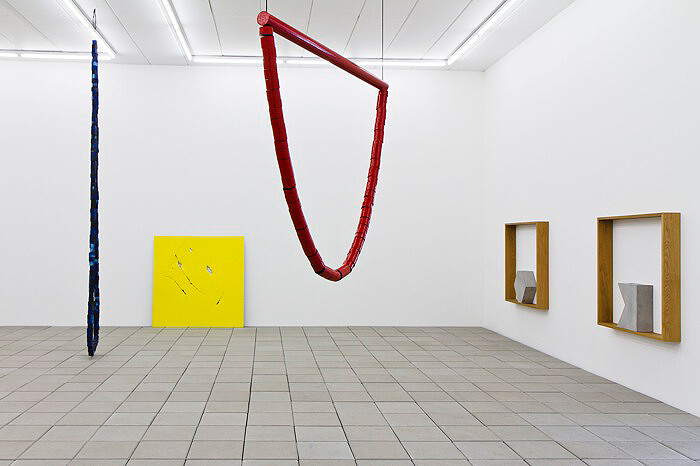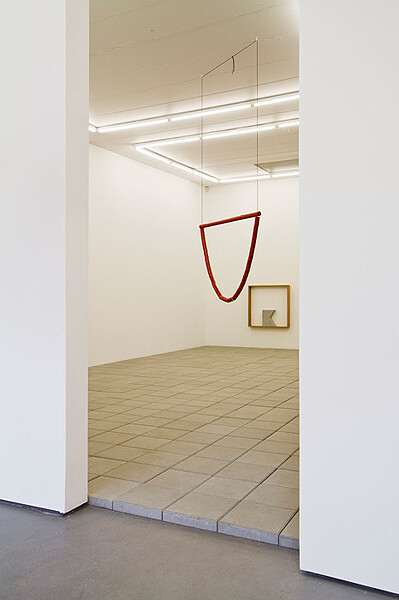While standing in “Spring Rain,” Norwegian artist Camilla Løw’s third solo exhibition at Elastic, a poem by American poet and essayist Charles Bernstein came to mind. “The Order Of…” was published in 1977 and is a playful meditation on issues surrounding epistemology and theoretical linguistics. Typographically inventive, it bears some resemblance to concrete poetry; words and letters shift in scale and location on the page. Although the poem could be superficially linked to the artist’s preference for concrete as a material, quite literally, what makes it relevant to Løw’s geometric sculptures are lines such as “hypostatization of space, the relations detemporalized,” and several stanzas later, vowels that scream:
“gEOmEtry,
rEgArdEd
As
ImmAnEnt.”
Engaging with the shapes that underlie everyday acts of speech—from typeset to linguistic conventions, or even a matrix of pixels on a screen—Bernstein’s text contrasts the abstractions and universal patterns of structuralism with the singularity of objects as strange as a “Mozambique sombrero” or as banal as a bale of wire. What Løw’s sculptures seem to share with the poem, then, is a formal concern for grammar and the convergence of spatial and linguistic relations; a sensibility rooted in the tension between the rule and its particulars. Indeed, Løw’s frequent use of basic shapes and primary colors suggests an interest in generative structures around which an infinite number of syntactic combinations can be built. Moreover, what stands out about her show at Elastic—and what further links it with the poem—is that space itself seems so absolute, so tangible.
To go inside “Spring Rain,” viewers had to first step up onto Strata (2012), a sculpture comprising a number of record-album-sized concrete tiles that cover the entire gallery floor. Although the work makes reference to the hyper-rationalism of twentieth-century city planning, this detail seems incidental when compared to its overall function within the show. As both a plinth and an ordering device, Strata spatializes a temporal register, demanding that viewers move up one level and reorient their bodies by means of an apparatus that, following Rosalind Krauss’s 1979 essay “Grids,” might be regarded as both non-hierarchical and anti-developmental. Atop this elevated vantage point, the other works in the show take on shades of authority—as though semantics had been simplified to grammar, displaced or floating free from the (art-) historical context and even, in some sense, embodiment.
One recurrent feature of Løw’s work is the use of an anthropometric scale. But this was not the case here. Gentle Midnight (2012) is a series of oak cubes spray-painted in dark blues and strung on a looped cord suspended from the ceiling—rather like an oversized necklace. Another ceiling-work, Robin (2013), looked like the clasp and semi-circular chain of a bracelet fit to adorn a gargantuan wrist. On a slightly different register, Fever (2013), is a large square sheet of perforated metal painted bright yellow; the expressive gashing of the surface brings the artist’s method of reduction to the fore while also marking an outburst of spontaneity in an otherwise highly-ordered environment.
As other reviewers have noted, Løw’s formal vocabulary—which is grounded in iconic visual languages of the Euro-American modernist canon, from Constructivism and De Stijl to Bauhaus and Minimalism—tends to summon social-utopian ambitions and structuralist ideas. Distancing the work from her predecessors’ universalizing tendencies as well as the desire for artistic autonomy, Løw embeds her sculptures in idiosyncratic reference systems, which are often unspoken or obscure. Spring Rain (2013), a series of angular concrete vessels inside low-hanging oak frames conjured up notions both of utilitarian design and the modular uniformity of industrial manufacture. Indeed, these sculptures looked as though they could be removed from their frames and used in Ikebana compositions—like decor without embellishment. According to Løw, the work takes its title from a song by a 1980s Australian pop-band called The Go-Betweens. Immediately preceding the chorus, it contains the refrain: “when will change come / just like spring rain?” It’s an appropriate question for an artist dealing with historical styles and formal repetition. But if this show was meant to reflect or instigate change then, to return to Bernstein, it’s of a “cosmetic order.”






